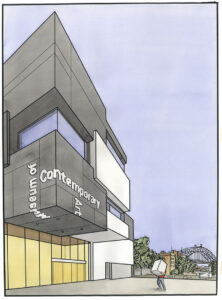MCA Sydney Simon FieldhouseAs of my last update in January 2022, the Museum of Contemporary Art (MCA) in Sydney, Australia, had undergone several significant extensions, each contributing to its stature as a world-class cultural institution. The MCA's commitment to expanding its facilities, enriching its collection, and enhancing visitor experiences has been an ongoing endeavor.
The MCA, situated in the iconic location of Circular Quay, unveiled its latest extensions aimed at furthering its mission to engage audiences with contemporary art in innovative ways. The extensions primarily focused on three core areas: architectural expansion, collection enhancement, and visitor engagement.
Firstly, the architectural transformation of the MCA has been remarkable. The extension project, led by a team of renowned architects, sought to not only expand exhibition spaces but also create a structure that harmonizes with the historic site while making a bold statement of contemporary design. The new architectural elements have allowed the MCA to accommodate larger and more diverse exhibitions, fostering a dynamic environment for artists and visitors alike.
Secondly, the extensions led to the enrichment of the MCA's collection. The museum has consistently acquired new artworks, ensuring a more comprehensive representation of contemporary art. Embracing various mediums and styles, these acquisitions have further diversified the MCA's collection, enabling a more inclusive and global perspective on contemporary artistic expression. Additionally, the museum has placed a heightened emphasis on supporting emerging artists, contributing to the vibrancy and diversity of the collection.
Thirdly, the MCA has strived to enhance visitor engagement through its extensions. Innovative technology, interactive displays, and educational programs have been integrated to create a more immersive experience for visitors of all ages. By offering guided tours, workshops, talks, and community events, the museum aims to foster a deeper connection between the art and its audience, making the MCA a hub for cultural exchange and learning.
Moreover, these extensions have not only augmented the physical space but have also been aimed at sustainability, with a focus on eco-friendly and energy-efficient designs, aligning the MCA with modern environmental standards and values.
The impact of these extensions has been profound, elevating the MCA's standing as a premier cultural destination in Australia and the global art community. The expansions have allowed for larger and more diverse exhibitions, a richer and more inclusive collection, and a more engaging and educational experience for visitors.
In conclusion, the recent extensions to the Museum of Contemporary Art in Sydney signify a monumental step forward in its evolution as a leading institution in the world of contemporary art. These expansions have not only elevated its physical presence but have also enriched its cultural significance, further cementing its role as a vital space for artistic expression, dialogue, and education. The MCA's commitment to evolution and innovation ensures that it remains a beacon of contemporary artistic excellence, captivating audiences and inspiring artists for years to come.
The MCA's architectural extensions were a testament to the careful integration of contemporary design into the rich historical fabric of Circular Quay. The challenge lay in expanding the museum's space while respecting the heritage-listed site and preserving the iconic views of Sydney Harbour.
Architectural renovations focused on several key elements:
- Sensitivity to Heritage: The architects paid meticulous attention to preserving the heritage aspects of the building. While the expansions added modern elements, they did so in a way that complemented and respected the existing structure.
- Synergy of Old and New: The design achieved a harmonious balance between the old and new, blending heritage elements with contemporary architectural features. This integration was aimed at providing a seamless transition for visitors moving through different sections of the museum.
- Spatial Enhancements: The extensions allowed for the creation of additional exhibition spaces, enabling the MCA to host larger and more diverse art exhibitions. The design facilitated flexible spaces that could adapt to various art forms and accommodate a range of artistic expressions.
- Aesthetic Appeal and Functionality: The architectural elements introduced modern aesthetics, while ensuring practical functionality. From the use of natural light to innovative interior design, the extensions aimed at creating an inviting and engaging environment for both art appreciation and visitor experiences.
- Sustainability and Environmental Consciousness: The architectural updates incorporated sustainable design elements, including energy-efficient systems, green spaces, and materials that reduced the environmental footprint of the building.
Furthermore, the extensions were intended not only to expand the physical space of the museum but also to enhance the overall experience for visitors. The architectural changes were part of a broader strategy to facilitate a more immersive and dynamic engagement with contemporary art, emphasizing the integration of technology and interactive elements within the museum spaces.
The success of the architectural extensions at the MCA lay not only in the physical expansion but also in the seamless integration of contemporary design with the historical context. These architectural innovations solidified the MCA's place as an iconic landmark in Sydney while positioning it as a global destination for contemporary art enthusiasts, artists, and cultural connoisseurs.
